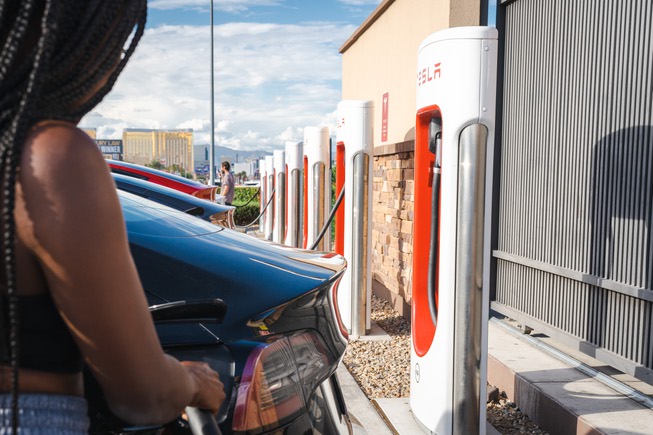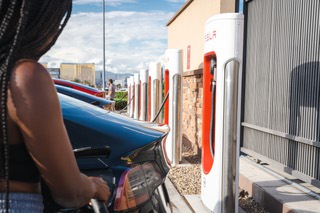
Nicole Clarkson unplugs her Tesla Model 3, after a quick charge at the busy Town Square Tesla charging station, off of Las Vegas Blvd. Monday, September 12, 2022.
Wednesday, Sept. 14, 2022 | 2 a.m.
As the sun set Monday on Las Vegas, Nicole Clarkson sat in her Tesla Model 3 as it charged near Town Square mall.
Clarkson, a Las Vegas freelance photographer and ride share driver, said it would take about 25 minutes to charge her car.
On this day, all but one of the chargers at Town Square, which are in the parking lot near the Lazy Dog restaurant, were in use.
There are close to a dozen Tesla charging stations around the Las Vegas Valley. Through technology that comes with a Tesla, drivers can see how busy a particular charging station is.
“I drive all over town, so I do come to this station, but it can be difficult to find a spot sometimes,” Clarkson said. “My go-to place to charge, without a doubt, is the station outside the Linq.”
For Tesla owners, the process of finding a charging station is relatively easy, but for the drivers of other types of electric cars, the system is not as streamlined, said David Knight, CEO of Terbine, a tech-based Las Vegas startup.
Drivers might worry about some trips based on available charging stations and whether a station is compatible with their car.
Those are problems Terbine is attempting to tackle.
The company, which has offices at the downtown Las Vegas Innovation Center, on Tuesday announced the framework for a machine learning system that would sync vehicles, charging infrastructure units and electric utilities to streamline the charging process.
Knight said Terbine officials have been in “serious talks” with about a dozen states and some utilities, including NV Energy, about the possibility of eventually instituting their system, which they’ve dubbed TerbineLink.
“The solution — that everything should work together — is straightforward,” Knight said. “Actually doing it, that’s super challenging, but that’s what we do.”
That challenge, Knight said, centers on bringing manufacturers, government officials and utility officials together.
The shift from gas-powered vehicles — whether personal cars or trucks or commercial vehicles — is gaining some momentum.
In California, the sale of new gasoline-powered cars is slated to be banned by 2035.
Last year, New York’s governor signed into law a measure that also sets a target of 2035 for the state to have a zero-emission standard for new vehicles.
Combined, those two states are home to just under 50 million people, close to a sixth of the population of the United States.
Jamie Allison, the former general manager of Ford Motor Company’s global retail connectivity operations and an advisor to Terbine, said disruptions from new modes of transportation have happened throughout American history.
“When you look through history, there’s always been these major shifts behind modality,” Allison said. “Let’s go all the way back to horses, then carriages, then the motor car. At first, there were no roads, so to speak, but the shift happened very quickly. The adaption accelerated and the infrastructure accelerated with it. Sometimes, the infrastructure takes a little longer to catch up to the availability of the products.”
Manufacturers, including Allison’s former company, have made commitments to invest billions of dollars into efforts related to the transition to electric vehicles.
From Ford to Honda to Kia and beyond, automakers have plans to roll out dozens of new electric vehicle models in the next two years.
Knight noted that over 200 new electric vehicle models are scheduled to come online in the U.S. and Europe by 2025.
“This is all happening amazingly fast,” Knight said. “If you think back to the first ATMs, people could only use their bank’s machine but, of course, that’s unheard of now because you can use ATMs all over the world.”
Because Terbine is based in Las Vegas, Knight said it had an inherent advantage in the electric vehicle technology space.
During a typical nonpandemic year, Las Vegas welcomes over 40 million visitors. Close to half of those visitors are from California, and many of them drive here.
“Southern Nevada is great place to test all of this because of how many cars come here from California and Arizona,” Knight said. “Southern California has one of the highest concentrations of EVs on the planet. About 41% of all EVs in America are in Southern California, so Las Vegas is a good place to be.”
Las Vegas city officials have been working with Terbine on the initiative.
Efforts like the one from Terbine are “key to achieving our sustainability goals as a city,” Michael Sherwood, the city’s chief innovation officer, said in a statement.
Through Terbine’s technology, “drivers of virtually any electric vehicle will be able to go anywhere with confidence, which will enable the industry to scale,” Sherwood said.
Allison said he’s sold on the impact Terbine’s technology can have on the electric vehicle changeover.
“The center of the future of getting the interoperability across this fragmented network — the center of EV charging streamlining — is being birthed right in Las Vegas,” Allison said. “Terbine’s job is to expand and scale and grow. This is going to require hand-to-hand combat in order to get all the stakeholders on board.”
Knight said one important factor with his company’s system was that it would not be consumed through a smartphone application.
Instead, it will be built into a vehicle’s navigation system, what Terbine calls a vehicle’s “infotainment” system.
Through the Terbine system, drivers would also be able to gauge how expensive a charge would be, and utilities would potentially be able to delegate power resources with a better understanding of where the charging hotspots are at a particular time, Knight said.
“There’s a lot of pushback right now on EVs, but, unfortunately, a lot of that is political,” Knight said. “Of course, when we were switching from horses to motor vehicles, people saw we didn’t have paved roads or gas stations. We’re going the phase now of not having enough gas stations. That’s where EVs are right now.”

